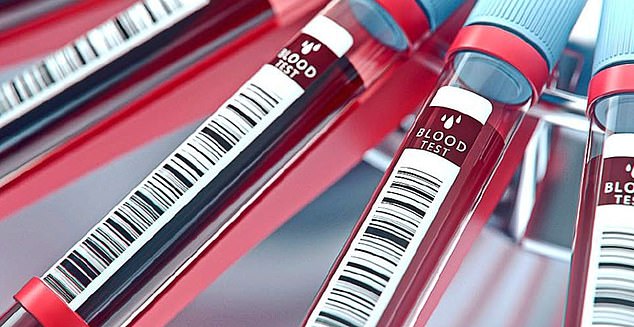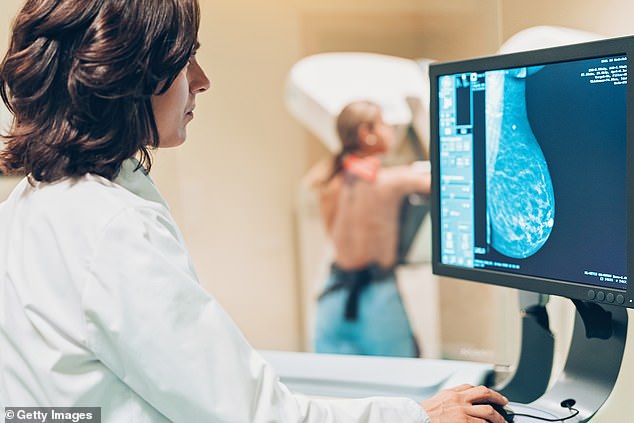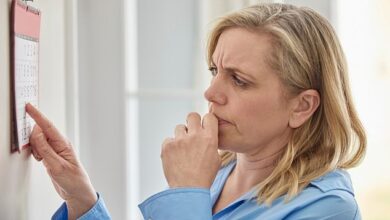Breast cancer runs in my family… this is what I discovered when I paid £449 for a new test that told me my risk






For people with a strong family history of breast cancer, the new blood cancer tests pose an interesting mystery.
Should we spend money and go to the private sector to have one of these ‘liquid biopsies’, which are still far from being available free on the NHS? Or do we stick with existing screening methods, such as the annual mammograms that I already have?
There is no doubt that we have entered a new era of cancer detection. But while it is of course great if it saves lives, it is still in its early stages and has not yet been thoroughly tested in large-scale trials.
A ‘liquid biopsy’ is a blood test that detects signs of cancerous tumors.

A ‘liquid biopsy’ is a blood test that detects signs of cancerous tumors. Some can identify more than 50 different types of cancer

The tests could be an alternative to annual mammograms for people with a family history of breast cancer
One of these is the Galleri test, currently being trialled by the NHS. This test looks for changes in fragments of genetic code – cell-free DNA (cfDNA) – that leak from tumours into the bloodstream.
It can help identify more than 50 different types of cancer (based on results reported so far, the test is currently not very good at detecting stage 1 cancer, where the cancer is small and has not yet spread to other parts of the body. The test is most reliable for later-stage tumors).
There’s also TruCheck, a proprietary test launched in the UK in late 2022. This test detects microscopic circulating tumour cells (CTCs) themselves, rather than genetic material leaked from tumours.
A 2021 study found that CTCs could help diagnose solid organ cancers: CTCs were found in 92.6 percent of samples from 6,025 people with symptoms who were later diagnosed with cancer (some of the researchers were employed by Datar Cancer Genetics, the company behind TruCheck).
The TruCheck test has an 88 percent sensitivity for detecting solid tumors, including breast cancer, according to the study in the journal Cancer Cytopathology. “These tests are an exciting development in cancer screening,” said Dr. John Pettit, an NHS GP who also works at Goodbody Clinic, one of TruCheck’s providers in the U.K.
“They can’t replace conventional screening yet, but they can complement it. Mammograms are harder to read in younger women because their breast tissue is denser. Some cancers can also be difficult to detect with a mammogram.”
These include lobular tumors, which grow not in a round mass but rather like a spiderweb or mesh. The ability of screening mammograms to detect cancer in women who have no symptoms such as an obvious lump ranges from as little as 30 percent in women with particularly dense breast tissue to 90 percent, studies show.
“Unlike mammography, TruCheck appears to be a highly accurate, noninvasive blood test that does not expose the patient to radiation and is much less uncomfortable,” Dr. Pettit said.
However, it is important to know that the amount of radiation released during a mammogram is low. Comparable to the amount of radiation we are exposed to during a long flight.
And Dr Liz O’Riordan, a retired breast surgeon and author of The Complete Guide To Breast Cancer, advises caution: ‘The aim of screening is to detect cancer at an early stage so that there is evidence that it can save lives if treated earlier.’
There is a lot of evidence for screening methods such as mammography and cervical smears, she says, “but this blood test has not been tested extensively. That means we don’t yet understand its full implications and the extent to which it will help reduce cancer deaths.”
The most comprehensive version of TruCheck looks for 70 different types of cancer and costs around £1,199.
There is a cheaper option (£449) that only looks for circulating breast cancer cells (the test cannot detect blood or lymphatic cancers, as only solid organ cancers produce CTCs).

One of the tests, Galleri, is currently being trialled by the NHS. Another, TruCheck, was launched privately in the UK in 2022
In addition to the lack of long-term research, there is another consideration: the fear that comes with taking a test. I know this after having the chance to try the TruCheck blood test myself.
Both of my older half-sisters were diagnosed with breast cancer—one at 38 and the other at 42—and my grandfather had prostate cancer (another risk factor). I am 45 and have had mammograms annually since I was 40.
After a pre-test counseling session with Dr. Pettit, where he explained to me how the test works, a nurse came to my house to draw blood. Then began a very anxious wait.
Results are typically returned within two to three weeks. Negative or positive, they are sent via email, with a follow-up call from the physician if positive.
You can buy the test without a doctor’s referral. You must be over 40 and not have had a previous diagnosis of cancer.
But Dr. Pettit says, “This is an evolving science, and these tests should only be performed under appropriate medical supervision, by a physician experienced in the test and the research behind it.”
He adds: ‘Positive results should only be interpreted by an oncologist as they may have various implications that need to be managed appropriately so that the patient can deal with any fears appropriately.

Mammograms can be difficult to read in younger women because their breast tissue is denser

Liquid biopsies can offer ‘short-term reassurance or a chance of early detection’, says NHS GP Dr John Pettit
‘Most GPs are not yet aware of the details of the development of these tests, but if someone with a positive result chooses to seek NHS care, Goodbody will provide all this information to their GP and ask that they be referred for advice and further testing via their local NHS cancer service with a ‘two week wait’.’
But as Dr O’Riordan, who has been treated for breast cancer himself, says: ‘If you don’t have urgent warning signs, you may not get into the NHS within the two-week waiting period.
‘How many tests, procedures and ‘scan anxiety’ do people with a positive result have to undergo and possibly find nothing?’
The risk of false-positive results – a result that indicates a condition exists when it does not – is a major concern for many regarding this new technology.
Dr. Pettit admits that false positives could be a problem: ‘We don’t know yet, but it’s possible that some living cancer cells will never become a clinical problem.
“However, it appears that the false-positive rate for TruCheck is currently lower than for mammography, the PSA blood test to detect prostate cancer, and the stool test for colon examination,” he says.
After waiting for two weeks, the email with my results arrived mid-morning. I was incredibly nervous—I actually got a migraine when I opened it—but deeply relieved when I read the results and discovered that no CTCs had been detected.
But as Dr. O’Riordan points out, it proves nothing. “Both false positives and false negatives are a problem,” she says. “This test can pick up cells that don’t mean anything, or it can miss cells, so people are falsely assured that they don’t have cancer and stop screening and monitoring themselves.
“We don’t know what it means in the long term if there are CTCs in the blood, so that’s another reason to take this with a grain of salt.”
She adds: ‘There is potential for these blood tests in the future, after the trials are repeated and it is proven that this detection method has an effect on outcomes.
“My concern at this point is that this is exploiting the wealthy. You are advised to repeat the test annually, which would be very expensive.”
Dr Pettit says: ‘The test will become cheaper and more accessible, but at the moment it may offer short-term reassurance or a chance of early detection for people with a strong family history of breast cancer or a known, established genetic risk.’
I feel reassured by my results, but after speaking to Dr O’Riordan I’m not sure I would put myself forward to have the test done privately again. These types of tests are undoubtedly a future mainstay of cancer screening, but for now I’ll stick with my annual mammograms through the NHS.




